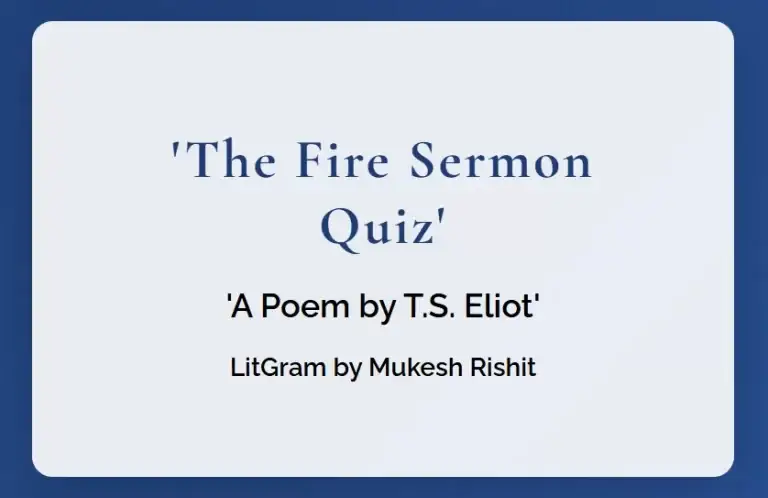Welcome to our comprehensive “The Fire Sermon Quiz,” the pivotal third section of T.S. Eliot’s modernist masterpiece, “The Waste Land.” This detailed quiz guide is essential for literature students, particularly those preparing for examinations like the RPSC First Grade English, where understanding modernist poetry is fundamental.
“The Fire Sermon” represents a crucial turning point in “The Waste Land,” drawing its title from Buddha’s sermon about renouncing earthly passions. This section masterfully weaves together themes of sexual degradation, spiritual desolation, and the polluted modern landscape of post-World War I society. With its intricate blend of high culture and contemporary life, this section offers a compelling commentary on the moral and spiritual bankruptcy of modern civilization.
Short Summary of The Fire Sermon
The section opens with a haunting riverside scene, where rats scurry among the garbage, setting the stage for a series of increasingly debased encounters. Through the voice of Tiresias – the blind prophet who has experienced life as both man and woman – Eliot presents a devastating critique of modern sexuality and human relationships. This quiz will challenge your understanding of these complex themes and their artistic presentation.
Key Learning Areas:
- The significance of the Buddha’s Fire Sermon and its modern applications
- The role of Tiresias as narrator and witness
- The symbolic importance of the River Thames
- Various literary and cultural allusions, from Spenser to Augustine
- The depiction of modern sexual relationships and their spiritual emptiness
- The use of multiple poetic forms and voices
This quiz is particularly valuable for:
- Students preparing for RPSC First Grade English examinations
- Literature enthusiasts seeking deeper understanding of modernist poetry
- Researchers studying the themes of waste and renewal in modern literature
- Anyone interested in T.S. Eliot’s poetic techniques and philosophical perspectives
As you progress through this quiz, you’ll encounter questions that:
- Analyze the complex symbolism of water and fire
- Examine the significance of various characters, from Mr. Eugenides to the typist
- Explore the intersection of Eastern and Western religious traditions
- Investigate Eliot’s use of musical elements and popular songs
- Consider the broader implications of the section’s themes in modern society
Understanding “The Fire Sermon” is crucial for:
- Grasping the overall structure of “The Waste Land”
- Appreciating Eliot’s modernist techniques
- Recognizing the influence of various cultural and religious traditions
- Comprehending the critique of modern society and relationships
Take This Quiz Too: A Game of Chess
Whether you’re preparing for an examination, conducting research, or simply seeking to deepen your appreciation of this masterpiece, this quiz will help you navigate the complexities of “The Fire Sermon.” Through careful analysis of its themes, techniques, and allusions, you’ll gain valuable insights into one of the most significant poems of the 20th century.
Ready to test your knowledge of “The Fire Sermon” and enhance your understanding of modernist poetry? Let’s begin this exploration of Eliot’s masterful critique of modern civilization and its spiritual crisis.


